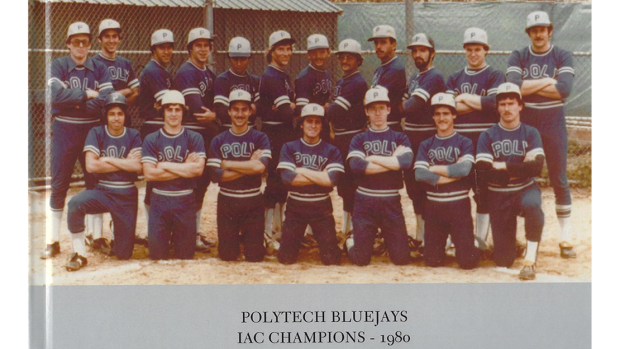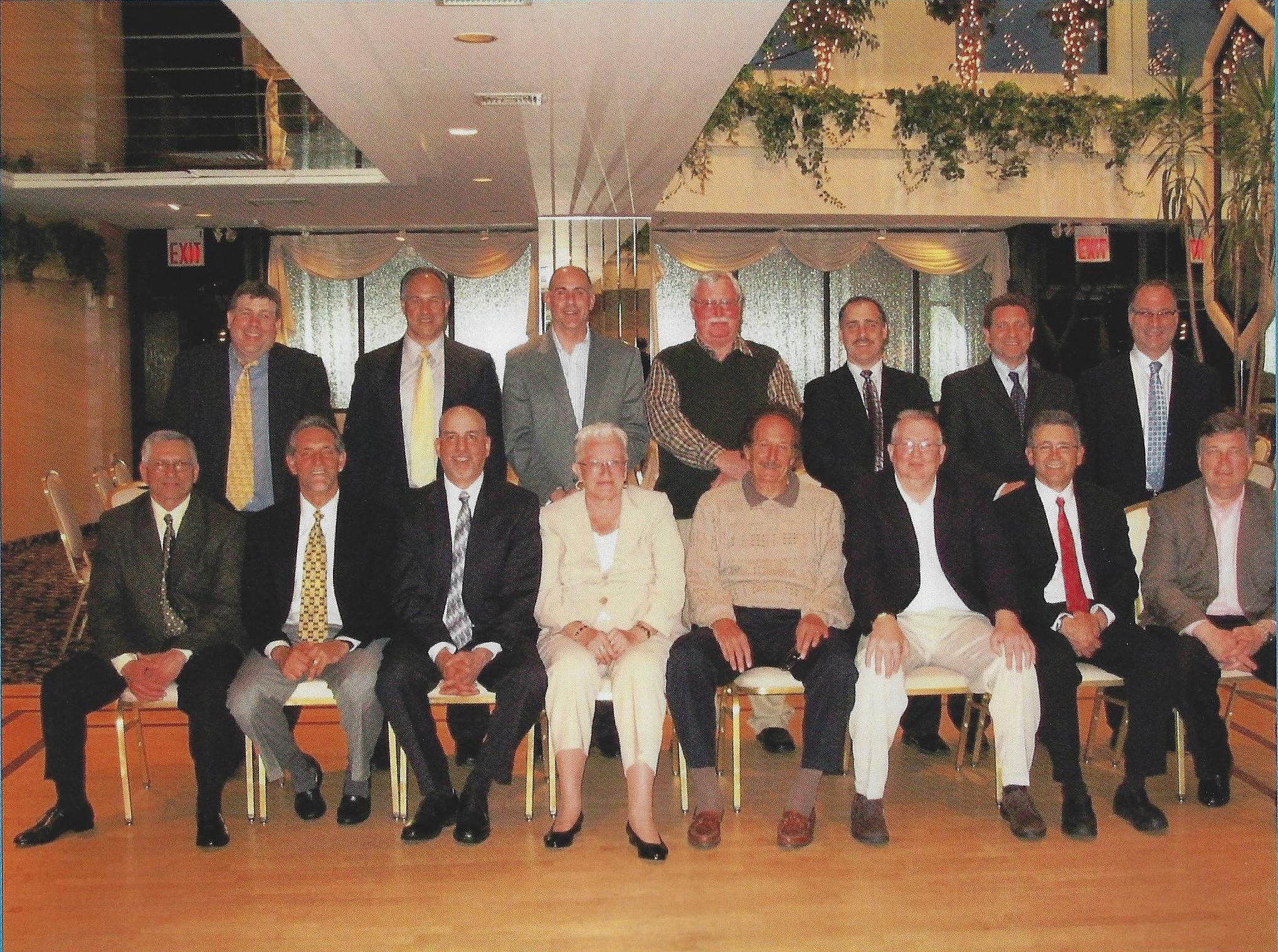Engineering a championship season
A look back at the scholar-athletes of the 1980 Poly Blue Jays

When Rich Rizza set his sights on becoming an engineer, like most students, he kept several factors in mind as he researched schools. Was there a rigorous curriculum that would leave him well-prepared for a career? Opportunities to do research? Top-notch faculty?
But Rizza had one more non-negotiable requirement: the captain of his Flushing High School’s baseball team, he wanted to continue to play in college. The school affectionately known as Brooklyn Poly (which, after many subsequent evolutions, is now known as NYU Tandon) fit the bill perfectly, and with the help of a Board of Trustees scholarship, he began studying electrical engineering in 1979.
As hoped, he also joined the Blue Jays, Poly’s baseball team. The team had been founded in 1880 — over the objections of President David H. Cochran, who reportedly frowned on college athletics of all types — and while it had been disbanded as the nation entered the Great Depression, it was resurrected in 1971 by Poly athletic director Joe Martini. In 1973 it became an NCAA Division III team and joined the newly formed Independent Athletic Conference, along with Stevens Institute of Technology, SUNY Maritime College, New Jersey Institute of Technology, Drew University, and other schools.
By the time Rizza arrived on campus, thanks in large part to assistant coach Dennis Murphy, the Blue Jays were a force to be reckoned with. “Even though Poly was a Division III school, many of my teammates were talented enough to play Division I ball,” Rizza recalls. “We had chosen Poly because we prioritized our engineering education and were playing simply for the joy of the game, rather than expecting the kind of glory heaped on Division I athletes.” (Teams at Division III schools compete at a high level without sports overshadowing academics; no athletic scholarships are awarded, and athletes must also be solid students. That can be especially challenging in the case of engineering students, given the rigor of STEM-based programs.)
Rizza and his teammates might not have expected glory, but it found them in 1980 anyway.
On April 15 of that year, in a game against Concordia, Jerry Heaney (‘82) allowed only four hits and set a Poly record with 20 strikeouts, while Mike Giannettino (‘82) racked up a home run and five RBIs, and Frank Marcazzo (‘82) went two-for-three at the plate, all of which contributed to the Blue Jays’ 17-1 triumph.
In their next game, against Drew University, Jim Graham singled in Rizza in the fifth inning, giving the Jays a 5-2 lead. Rizza had led off the inning with a walk and advanced to second when catcher Mike Gresh (‘82) walked. Team Captain Tommy Francavilla (‘80), who would later become a Blue Jays coach, led the plate assault with three hits on four turns, knocking in two runs and stealing two bases, and Heaney — ultimately named Conference MVP and Poly Athlete of the Year — once again proved himself a star.
With competition heating up, Poly, 7-6 after their win over Drew, faced Stevens on May 4 in a double-header, which they needed to sweep in order to tie New Jersey Institute of Technology for the league lead. They won the first game in a nail-biter, 3-2, then rolled to victory in Game 2, by a score of 9-1.
Finally, after being rained out, on May 14, Poly and New Jersey Institute of Technology vied for the conference championship. Heaney pitched another gem, shortstop Giannettino drove in the winning run with a single in the fourth, and the Blue Jays garnered, as a New York Daily News reporter wrote, “their first championship in any sport since World War II.”
The players still remember that 3-1 game as a highlight of their college athletics career. Most still keep in touch, and they hold regular reunions. (They had a gala banquet in 2011, during which the entire team was honored by Athletic Director Maureen Braziel, and while the COVID-19 pandemic derailed plans for a commemoration of the 40th anniversary of the championship, they still met via Zoom to celebrate.)

Rizza, who remains an active alum and has returned to the school to judge capstone competitions, remembers a showcase in the gym lobby of Poly’s now-shuttered Farmingdale campus that held memorabilia from all its teams, including basketball and wrestling. He would love to one day see it exhibited again, he says, “to celebrate the fact that the school’s scientists and engineers can also be accomplished athletes.”
One for the record books
When Heaney struck out 20 on April 15, 1980, he broke the NCAA Division III record of 19, which had been set in 1974. He held the record for almost two decades, until it was tied in 1991. His accomplishment was finally recognized by the NCAA in 2022, and his name was entered into the record book. Heaney was inducted into the Independent Athletic Conference Hall of Fame, which was established on the 20th anniversary of the IAC conference. Only four baseball players over that 20-year span were inducted.
Tom Francavilla has stories ...
When I think back on the baseball team at Poly, the team van ties it all together best — the baseball, the friendships, the day-to-day life of commuting to school in downtown Brooklyn.
In the late 1970s, the athletic department, with cooperation from the school administration, purchased a van. The van would be used by the athletic department to take teams to sporting events since we did not have a home baseball field or gym, and in return, the school would use it as needed during non-sporting event days and would take responsibility for maintaining it in good condition.
In 1980, after our team’s spring trip to Florida, we returned for the start of our local baseball season — just in time for the NYC transit strike. I asked Baseball Coach and Athletic Director Joe Martini if we could use the van to get back and forth to school during the strike. He agreed and for the first couple of days I picked up a half-dozen teammates on the way to school. (We would even meet for breakfast at one of the guy’s apartments.) We’d park the van in the school lot, and when it was time to go home after classes the van would have a full tank of gas thanks to the maintenance department.
We eventually started to use the van to go out at night and on the weekends. The coach wasn’t aware of the extra activities; in his eyes, my teammates and I could do no wrong as we continued to win on the baseball field. On the day before our conference championship game against NJIT, we scrimmaged LIU at their Flatbush Ave field. During the scrimmage, our coach agreed to let LIU use our team van for transportation to their ECAC playoff game against St. John’s University the next day. The only problem — I had not brought the van to the scrimmage. I left it home because the night before we had damaged it, and the passenger door was unhinged. I had to go home after the scrimmage, get the van, and return to LIU the next morning before our game, to give their team the van — with the damaged door.
Later that day, we won our conference championship game 3-2 against NJIT. And after the game we waited for LIU to return with the van — so the coach wouldn’t see the damage — and more importantly, so we had transportation for our championship night celebration in Brooklyn.
To me, the van symbolizes life at Poly during our championship season. We rode the van to various schools in the tri-state area, discussing baseball strategy on the way to the game and reliving the highlights on the way back to campus. Every trip — sanctioned or not — bonded our team closer, and it’s a bond that has lasted over 40 years. Only at Poly would a van provide a means to engineering degrees, a conference baseball championship, and even a few beers since the legal drinking age was 18 back then.
One final note: We took the van to Boston after the season for a long weekend celebration . . . but that’s a whole other story!


